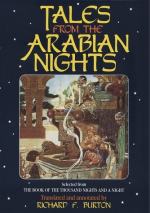5. La Mille et deuxieme Nuit, par Theophilus
Gautier (Paris,
1880). Probably
Class 1 or 2; I have not seen it.
B.—English.
1. The Vision of Mirza (Addison in the “Spectator"). Class 3.
2. The Story of Amurath. Class 3. I do not know the author. I read it in a juvenile book published about the end of last century, entitled the Pleasing Instructor.
3. The Persian Tales of Inatulla of Delhi. Published in 1768, by Colonel Alexander Dow at Edinburgh. A French translation appeared at Amsterdam in two vols. and in Paris in one vol. (1769). Class 6. Chiefly founded on a wellknown Persian work, of which a more correct, though still incomplete, version was published in 3 vols. by Jonathan Scott in 1799, under the title of Bahar Danush, or Garden of Knowledge.
5. Rasselas, by Samuel Johnson. Class
3. Too well known to need
comment.
6. Almoran and Hamet, by Dr. Hawksworth. Class 3. Very popular at the beginning of the present century, but now forgotten.
7. Oriental Fairy Tales (London, 1853). Class 4. A series of very pretty fairy tales, by an anonymous author, in which the scene is laid in the East (especially Egypt).
8. The Shaving of Shagpat, by George Meredith (London, 1855). Class 5. I prefer this to most other imitations of an Oriental tale.
9. The Thousand and One Humbugs. Classes 1 and 2. Published in “Household Words,” vol. xi. (1855) pp. 265-267, 289-292, 313-316. Parodies on Nos. 1, 195, 6d, and 6e,f.
10. Eastern Tales, by many story-tellers. Compiled and edited from ancient and modern authors by Mrs. Valentine, author of “Sea Fights and Land Battles,” &c. (Chandos Classics.)
In her preface, the authoress states that the tales “are gathered from both ancient and modern French, Italian and English sources.”
Contains 14 tales, some genuine, others imitations, One, “Alischar and Smaragdine,” is a genuine story of The Nights (No. 41 of our Table), and is probably taken from Trebutien. Three tales, “Jalaladeen,” “Haschem,” and “Jussuf,” are Grimm’s imitations, taken probably from the composite English edition of 1847, and with the same illustrations. “The Seven Sleepers” and the “Four Talismans” are from the Count de Caylus’ tales; “Halechalbe” and “Bohetzad” (our No. 174) are from Chavis and Cazotte; “The Enchanters” and “Urad” are from the “Tales of the Genii”; and “The Pantofles” is the well-known story of the miser Casem and his slippers, but I know not where it first appeared. The remaining three tales are unknown to me, and as I have seen no volume of Italian Oriental tales, some, no doubt, are derived from the Italian sources of which the authoress spoke. They are the following: “The Prince and the Lions,” “The City of the Demons” (a Jewish story purporting to have been written in England) and “Sadik Beg.”
11. New Arabian Nights, by R. L. Stevenson (London, 1882).




